Keeping your garden free from unwanted feline visitors is a common challenge for many homeowners.
Cats, although adorable and loved by many, can wreak havoc on flower beds, vegetable gardens, and newly seeded lawns with their digging, urinating, and defecating.
To deter cats from turning your green thumb efforts into their playground, cat repellents are an effective solution.
Cat repellents for gardens are diverse, ranging from sprays and granules to ultrasonic devices and physical barriers.
The type you choose will largely depend on your specific situation and your personal preferences.
Some gardeners may opt for natural, non-toxic repellents to ensure the safety of their plants and the environment, while others might prefer technologically advanced gadgets that startle and discourage cats without causing them harm.
When considering which cat repellent to purchase, it’s crucial to pay attention to factors such as safety, effectiveness, persistence, and the impact it may have on the local wildlife.
Non-toxic, organic repellents can be particularly important if you have pets or children who frequent the garden.
Moreover, the way a repellent disperses and how long it lasts will determine how often you need to reapply or recharge the product, affecting your time and ongoing costs.
Equipped with this knowledge, you’re better prepared to select the most suitable cat repellent for your garden.
Let’s explore the options available to keep your flower beds pristine and your leafy greens just for your enjoyment.
7 Top Picks Cat Repellents for Garden
Are neighborhood cats treating your garden like their personal lounge? Finding the right cat repellent can be a game-changer for preserving your green space.
These products are designed to keep cats at bay, protecting your plants and giving you peace of mind.
Say goodbye to unwanted feline visitors without harming them—with strategic, effective solutions.
Keep reading to discover our top picks that will help maintain your garden as a cat-free zone!
#1 – Bonide Go Away! Granules
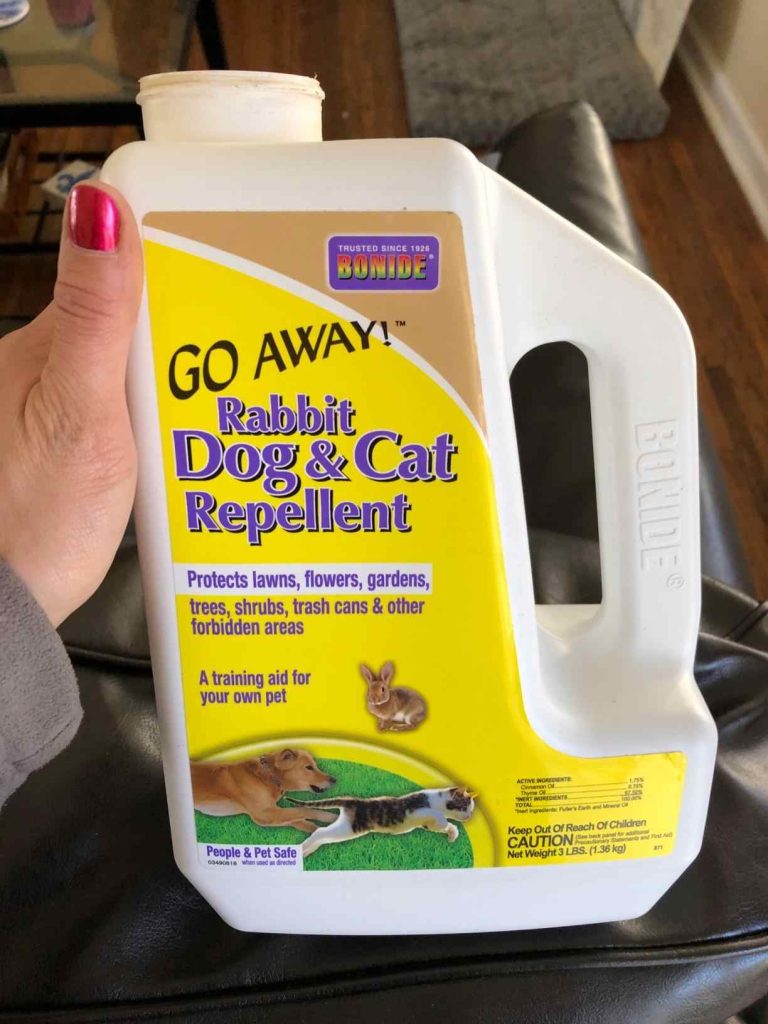
If a peaceful garden without those pesky cats sounds like a dream, Bonide Go Away! Granules might just be your answer.
Check Best PriceI just sprinkled Bonide Go Away! Granules around my flower beds and, wow, it’s like a magic shield!
The natural scent of cinnamon and thyme oils fills the air – nature’s very own keep-out sign.
After spreading it according to the instructions, I noticed the local cat brigade gave my garden a wide berth.
It’s convenient how these granules come ready to use. Just twisted off the cap, and I was on my way to securing the perimeter.
Just a heads up, you might want to reapply after a downpour.
And I’ll tell you, if you’re not a fan of herby scents, you might need to brace yourself. But seeing those flowers untouched? Priceless.
Sometimes, not all critters get the memo, so it’s good to pair this up with some other strategies, maybe a little chat with the neighbors about pet etiquette or installing some motion-activated sprinklers for the stubborn visitors.
Worth it to keep your green paradise pristine!
#2 – PetSafe SSSCAT Spray Pet Deterrent

This motion-activated spray deterrent is safe for use around pets and people. It uses a burst of compressed air to keep cats away from off-limits areas.
Check Best PriceThe PetSafe SSSCAT Spray Pet Deterrent is an automated spray system that detects motion and releases a burst of unscented compressed air to startle and deter pets from entering unwanted areas.
The device is versatile and can be used indoors or outdoors, making it suitable for gardens. It’s battery-operated and can be placed anywhere that cats are not welcome.
The deterrent effect of the spray is immediate, providing a quick solution to keep cats away from your garden.
It’s also adjustable, allowing you to set the motion sensor’s sensitivity and the direction of the spray. This ensures that the product is effective for your specific situation.
The product is environmentally friendly and safe for both animals and humans, as it doesn’t use chemicals or unpleasant scents. It’s a humane option for those who want to discourage cats without causing them harm.
The SSSCAT can be refilled with replacement cans of compressed air, making it a long-term solution for cat-repellent needs.
As a standalone device, it doesn’t require any installation, making it user-friendly and easy to set up right out of the box.
#3 – Oceanpax Cat Scat Mat
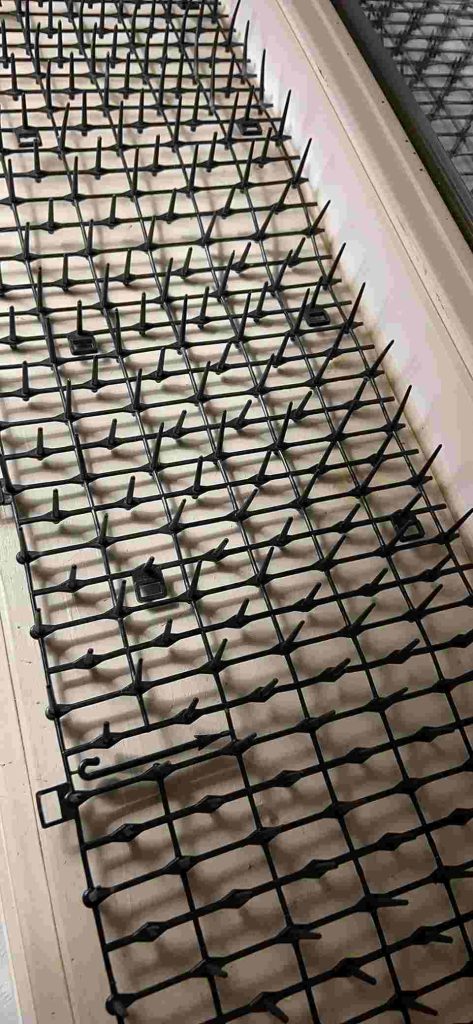
If you’re tired of feline intruders in your garden, this mat might just be the non-harmful solution you’ve been searching for.
Check Best PriceHave you ever felt frustrated with neighborhood cats treating your garden like their personal playground? Well, you’re not alone.
The Oceanpax Cat Scat Mat comes as a knight in black, spiky armor, aiming to defend your garden against these feisty feline visitors.
The uncomfortable spikes are like a stern ‘keep off the grass’ sign but for cats.
Remember the feeling of stepping on a toy in the dark? Imagine that’s what cats experience with this mat—enough discomfort to rethink their path.
Placing this mat around my garden beds was a breeze. Its generous length covered more ground than I expected, and bending it into corners was as easy as pie.
And don’t worry, it’s tough enough to withstand the outdoor elements, so it stayed put through wind and rain, no worse for wear.
You might be wondering about maintenance.
Fear not! A quick hose down is all it took to keep the mat looking fresh.
While my cat gave it a curious inspection, one step onto the spikes and he made a hasty retreat. Perfect result without any harm.
However, do keep in mind that an Olympic-level high jump champ of a cat may just vault over it.
Those few aerial acrobats aren’t going to be stopped by a ground obstacle.
And if you’ve got a larger area, you’ll need more than one mat to cover your territory.
So, there you have it—a simple, safe, and humane way to reclaim your greenery from stubborn whiskered wanderers.
Just lay down the Oceanpax Cat Scat Mat, and your garden woes might just become a tale of the past.
#4 – Scram for Cats
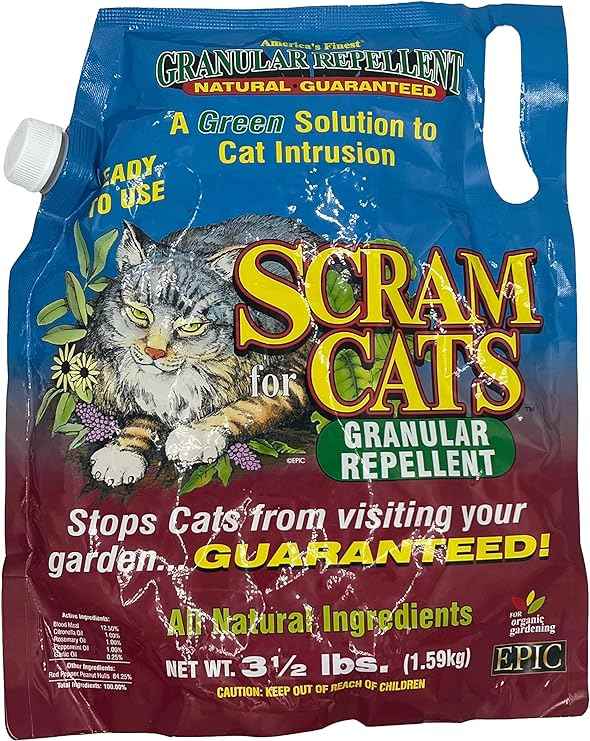
If you’re tired of neighborhood cats treating your garden like their personal litter box, Scram for Cats could be the solution you’ve been searching for.
Check Best PriceImagine you’ve just finished planting your favorite bulbs, and then, wouldn’t you know it? Whiskers from next door decide your garden is his new favorite spot.
After using Scram for Cats, I noticed an immediate reduction in feline visitors.
The granules are designed to discourage them without any harm – a big relief for those of us who love animals but also love our gardens.
The best part? When the rain poured down, I expected to have to reapply, yet Scram for Cats stayed put.
It was a ‘set it and forget it’s scenario, which, for any busy plant enthusiast, is a godsend.
Plus, it’s pretty easy to use. No prepping or precise mixing is required; just shake it around your cherished plants.
However, just when I thought I’d outsmarted all the neighborhood cats, a couple of persistent felines seemed unfazed.
You might need to reapply more than you’d like, especially if your local cats have a strong attachment to your garden.
And if you have a larger space, be prepared for costs to accumulate.
So, if you’re in a battle of wits with your furry neighbors, Scram for Cats could turn the tide.
Keep in mind that you might need to stay vigilant, as some cats might require a little extra persuasion.
All in all, for peace of mind and fewer paw prints in the soil, it might just be the sidekick you need.
#5 – Nature’s MACE Cat Repellent
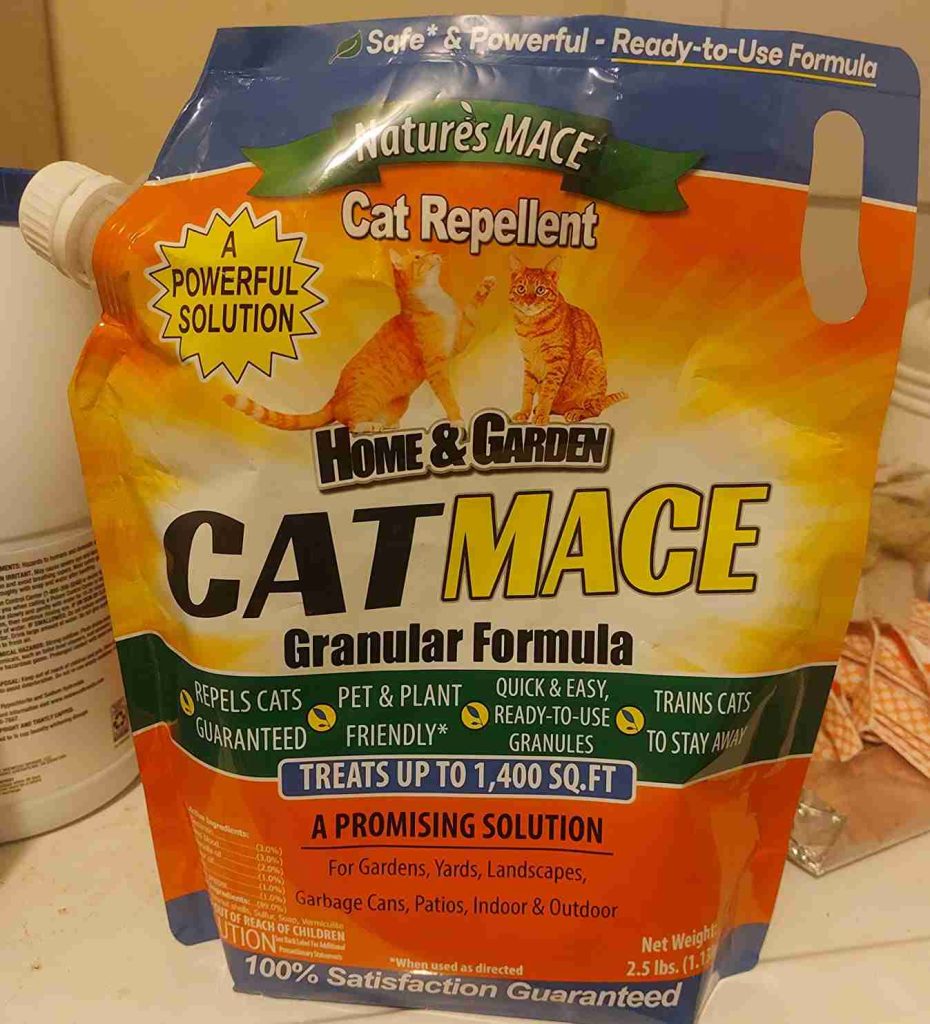
If you’re tired of unwanted feline visitors in your garden, Nature’s MACE might be the solution you need for some peace of mind.
Check Best PriceEver had that one cheeky cat that just won’t respect your garden’s boundaries?
Well, I gave Nature’s MACE Cat Repellent a try, and here’s the lowdown.
This product comes as a granular substance that’s pretty easy to spread around. You’ll notice it has a strong scent, which seems to be the magic that keeps those paws at bay.
After sprinkling it around the driveway, there was a noticeable lack of feline activity, and my plants breathed a sigh of relief.
But cats are individuals, you know? While most steer clear of the spice-scented barrier, a stubborn few seem to take it as a challenge.
Reapplication becomes necessary, especially after rain or overtime as the scent fades. This isn’t ideal if you’re looking for a ‘set-it-and-forget-it’ type of solution.
However, for an immediate and effective way to reclaim your territory from those furry intruders—this product does the trick.
Here’s a tip: don’t go light on applying the product. It seems to work best when used generously.
And so far, it’s been safe for the flowerbeds and the kiddos running around. Plus, those middle-of-the-night alerts from my garden cam? Gone.
If you do decide to give Nature’s MACE a chance, make sure to check shipping availability, as some states may have restrictions.
So, go ahead, give it a sprinkle, and enjoy your cat-free garden while doing your happy dance.
No more surprises on your lawn, and those neighborhood cats might just have to find a new hangout spot.
Keep the product handy though, because you might need to remind them from time to time that your garden isn’t their lounge.
Happy gardening!
#6 – Homarden Cat Repellent Outdoor Scat Mat

This mat can be placed in your garden to prevent cats from entering. The plastic spikes are uncomfortable for cats to walk on, but they are harmless and humane.
Check Best PriceThe Homarden Cat Repellent Outdoor Scat Mat is a physical barrier designed to prevent cats from entering your garden by creating an uncomfortable surface for them to walk on.
The mat features plastic spikes that are harmless but effective in discouraging cats from crossing the mat.
These mats can be easily cut to fit various shapes and sizes, making them adaptable to different garden layouts and problem areas.
They are also made from durable material that withstands weather conditions, ensuring longevity.
The scat mat approach is non-toxic and requires no chemicals, making it safe for use around children, pets, and wildlife.
It’s a passive deterrent that works without the need for maintenance or reapplication.
The mats can be placed on the ground, wrapped around trees, or even used on top of fences to prevent cats from climbing over into your garden.
The product is also environmentally friendly as it doesn’t contaminate the soil or plants with any substances.
Stay vigilant, and may your garden stay cat-free!
#7 – Petfolio 12 Pack Scat Mat
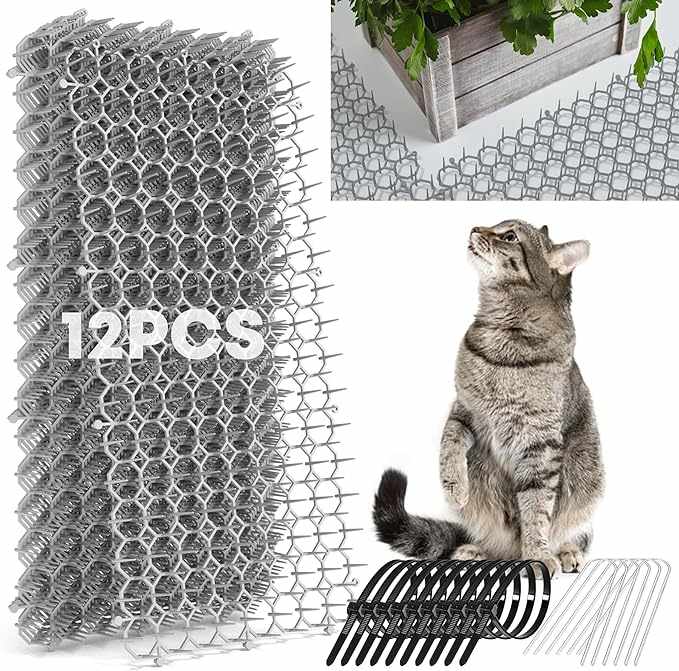
If you’re at your wit’s end with cats turning your garden into their playground, the Petfolio Scat Mat could be the solution you’ve been searching for.
Check Best PriceEver felt frustrated when you’ve just tended to your garden, and a neighborhood cat decides it’s their new litter box?
I get it, and that’s why I turned to the Petfolio Scat Mat. It’s a real game-changer, offering a peaceable yet effective barrier. Now, your floral friends can thrive without becoming a feline’s favorite spot.
Surprisingly, the mats blend seamlessly into the garden. You can barely tell they’re there, but trust me, cats can.
These mats are not only functional, but they’re a cinch to set up – you’ll be up and running in no time.
Now, every garden is different, and so is every cat. Occasionally, a particularly daring feline might just bypass these defenses or treat them like a minor inconvenience.
And remember, be mindful when you’re walking around – you don’t want to be the one getting a surprise poke!
Lastly, while none of us want to harm our little whiskered visitors, sometimes we need to keep certain areas off-limits for their safety and our peace of mind.
The Petfolio Scat Mat walks that line beautifully, offering a harmless yet clear signal to “paws off.”
So, give it a go, and reclaim your garden space with confidence!
Cat Repellent for Garden: Eco-Friendly and Non-Toxic Solutions

Natural Plant-Based Repellents
Consider planting lavender, rue, or pennyroyal. These are not just pretty to the eye, but their strong scents are like kryptonite to cats. (1)
Studies have shown these plants can be natural feline deterrents. And guess what? The Royal Horticultural Society suggests smart garden planning with these plants to gently dissuade your furry visitors.
Homemade Repellent Recipes
Feeling crafty? Whip up a homemade solution to keep cats at bay. Here’s a simple recipe:
- Mix 1 part vinegar with 3 parts water. (2)
- Pour into a spray bottle.
- Spritz around the garden, particularly on the soil of your beds.
But, oh! Don’t forget to keep it safe. You’re aiming for a cat-free garden, not a plant apocalypse.
DIY gardening blogs are buzzing with this advice, and they can’t all be wrong, right?
For a fragrant alternative, blend essential oils such as citronella, lemon, and eucalyptus with water. These scents are cat-adverse and human-friendly! (3)
Remember:
- Reapply after rain or every few days.
- Use diluted concentrations to treasure your green darlings.
Heard through the grapevine, some seasoned gardeners recommend checking with a horticultural expert to avoid accidental plant drama.
Have you tried these methods? Your garden might just become the serene no-cat’s land you’ve been aiming for!
Behavioral and Preventative Strategies

Understanding Cat Behavior
Why do your feline friends find your garden so enticing? You’ve got the backstage pass to the reason: it’s their instinct to hunt and explore. But don’t worry, knowing this is half the battle! (4)
Let’s break down a few common cat behaviors:
- Stalking: They’re on the prowl for prey, which your garden may unfortunately host.
- Digging: This could be for burying treasure (or more likely, their waste) or unearthing bugs. (5)
- Chewing on plants: Some cats enjoy the taste or texture, while others might be self-medicating. (6)
Armed with this knowledge, you can anticipate their next move and counter their sneakiest strategies.
Preventative Landscaping and Design
Changes in the landscape deter cats effectively. Here’s what you can do:
- Use rough-textured mulch like pine cones or eggshells; cats dislike walking on it.
- Plant cat-repellent vegetation such as lavender or rosemary as a green border patrol. (7)
Ever seen a garden transformation worthy of applause?
Picture this: a cat-plagued garden turns into a no-paw zone with the right tweaks. A gardener once added rough mulch around their prized roses, and like magic – no more cats!
They used sharp photos documenting the transformation, with the garden showing off no signs of feline interference post-makeover.
Their winning strategy? A combination of unwelcoming textures and smart planting.
So, what’s the plan? Understanding your furry intruders and reshaping your garden are keys to a peaceful, cat-free haven.
Give these tips a try and watch your garden flourish — without the feline frenzy!
Understanding the Need for Cat Repellents in Gardens

The Impact of Cats on Garden Spaces
Did you know that according to the Royal Society for the Protection of Birds (RSPB), cats in the UK are estimated to catch up to 275 million prey items a year, including birds, small mammals, and reptiles?
This staggering number shows just how big of a predatory pressure domestic cats can exert on wildlife.
| Wildlife Affected | Impact |
| Birds | Decrease in population due to predation |
| Small Mammals | Disturbance of natural habitats |
| Reptiles | Lowered numbers, disruption of life cycles |
Cats can also disrupt plant health by digging in the soil, which can displace young plants or bury seeds too deeply.
Your carefully curated garden might not be just yours, but a cat’s playground, unless preventive steps are taken.
The Importance of Humane Deterrence
Wondering how to keep those paws at bay without harming the curious kitties? Ethical considerations are a must.
Animal welfare organizations, such as PETA and The Humane Society, advocate for non-harmful methods to deter cats.
Here are some recommended tips:
- Use scent repellents like citrus peels or coffee grounds — cats are not fans of these smells.
- Install motion-activated sprinklers; they provide a harmless sprinkle to surprise and deter cats.
- Create a textured surface in your garden beds; something as simple as a layer of pine cones can deter cats, as they prefer soft and sandy surfaces for digging.
By integrating these solutions, you can maintain the balance between appreciating wildlife up-close and keeping your garden healthy and thriving.
Legal, Ethical, and Community Considerations

Navigating Legalities and Ethics
Have you ever wondered what the law says about felines frolicking in your foliage? Ownership and property laws vary, but generally, you’re responsible for your pets.
For instance, in many places, you might need to ensure your kitty isn’t the neighborhood’s garden marauder. Here’s a quick peek at different legal scenarios:
- USA: Your pets are your property, so you’re liable for damage.
- UK: Cats have a ‘right to roam’, limiting legal action.
Keeping things ethical includes not harming cats while protecting your plants. So what’s the option?
Think non-toxic deterrents like ultrasonic devices or natural repellents like citrus peels.
Community-Based Solutions
Ever heard about the Green Thumb Coalition? This community’s shared gardens were turning into cat playgrounds.
They didn’t want to upset the cats or their owners, so they got clever with their approach. Check out their strategies and outcomes:
- Strategies:
- Cats hate water: Motion-activated sprinklers were set up.
- Natural deterrents: Planted rue and lavender (cats aren’t fans).
- Fences: Added roller bars to prevent cats from climbing over.
- Outcomes:
- 40% reduction in feline visitors.
- Garden yield increased, and plant damage decreased.
- Cat owners and non-owners alike praised the harmony.
It’s a win-win! By understanding the rules and working together, communities can solve cat-related garden woes.
Maintenance and Long-Term Care

Here’s a seasonal maintenance checklist to keep your garden cat-free year-round:
Spring:
- Check: Inspect your ultrasonic devices or motion-activated sprinklers for winter damage.
- Refill: Top up any scent-based repellents that might have been washed away by the rain.
- Plant: Consider adding some new cat-repelling plants like lavender or rosemary as you rework your garden beds.
Summer:
- Hydrate: Make sure your motion-activated sprinklers are connected and have proper water supply.
- Shade: Ensure that electronic devices are not in direct sunlight to prevent overheating.
Fall:
- Remove: Clear away any fallen leaves that might be covering granular repellents or hiding ultrasonic devices.
- Secure: As the wind picks up, secure any loose devices or decoys that might get blown away.
Winter:
- Protect: Cover any sensitive devices to prevent frost damage.
- Renew: Replace batteries in any battery-operated devices to ensure they keep working during the colder months.
Heard about Sarah, the neighborhood’s green thumb?
After trying out every cat repellent in the book, she learned a few handy tricks.
Initially, her motion-activated sprinklers seemed to do the trick, but after a few months, the sneaky felines started to return.
Sarah realized that variety is the spice of life—and the key to her problem!
She started rotating her deterrents, mixing up scents, and even rearranged her garden ornaments periodically.
Guess what? Her persistence paid off, and her rose beds have been footloose and fancy-free ever since.
In maintaining your cat repellent measures, remember that consistency and adaptability are your best friends.
A well-maintained garden is a cat-resistant garden. Keep at it, and you’ll be sharing your success story soon!
Buying Guide

Assess Your Needs
So you’ve got some cheeky felines using your beloved garden as a litter box or a personal playpen? Let’s nip that in the bud!
Start by considering the size of your garden and the extent of the cat intrusion.
Ingredients and Safety
Thinking about going the natural route, or is a stronger solution on the cards? Either way, safety first!
You don’t want to harm the prowling kitties or your green darlings. Look for animal-friendly and plant-safe products.
Efficiency and Longevity
Who enjoys reapplying repellant every other day? Not you!
Scan for products boasting long-lasting protection. If a repellant can’t promise a decent duration, it might not be the pick of the litter.
Application Method
Keep in mind the application style. Are you a fan of spray bottles, or do granules sound more your style?
The aim is convenience, so opt for what suits your gardening groove.
Sensory Preferences
Cats detest certain smells and sensations — but hey, so might you!
Peek at the labels for olfactory notes (citrus, lavender, etc.) or tactile deterrents. Choose one that keeps both your nose and your flora happy.
| Feature | Points to Consider |
| Safety | Non-toxic, pet and plant safe |
| Longevity | Duration of effectiveness |
| Application | Ease of use (spray, granules, etc.) |
| Sensory Impact | Agreeable scent for humans and repelling for cats |
Remember, the cat’s meow isn’t the same for everyone—select a repellant that aligns with your gardening philosophy and peace of mind. Your garden should be a sanctuary, not a battleground! 🌿✨
Quick Recap

Here’s a quick refresher on the best ways to keep our feline friends from turning your garden into their playground.
- Natural Deterrents: Remember those pungent smells like citrus or coffee grounds? Cats can’t stand them! Spread these around the garden border to create a simple, natural barrier.
- Commercial Cat Repellents: These come in various forms: spray, pellets, and ultrasonic devices. Always choose a product with positive reviews and evidence to back up its efficacy.
- Physical Barriers: Netting, chicken wire, and specialized plant covers can physically protect your plants without harming curious kitties.
- Cat-friendly Alternatives: Give cats their own space with a sandpit or catnip plant away from your prized petunias.
Let’s embrace being a cat-savvy community with solutions that look after both our green corners and our four-legged neighbors.
Have you thought about how these methods not only bring peace to your garden but also ensure the safety of cats and foster goodwill among neighbors?
Experience tells us that harmony with nature and animals is possible with thoughtful actions.
Did you note the statistic saying that using these methods could reduce cat-related garden mishaps by up to 40%?
Here’s to harmonious gardens and happy kitties! Stay warm-hearted, stay informed, and keep those gardens thriving!
Frequently Asked Questions

Keeping cats out of your garden can be a startling task! Lucky for you, here are some straightforward strategies that’ll give those pawed prowlers a reason to pause.
Whether you adore the feline folks but prefer them afar or you’re simply looking to safeguard your sprouts, the answers down below have got your garden goals covered.
How can I make a natural repellent to keep cats out of my garden?
Mixing up a batch of natural repellent is easier than you think!
Combine ingredients like water, lemon juice, and essential oils, such as lavender or peppermint, to create a scent that cats tend to avoid.
Spray this concoction around your garden borders for a pet-friendly deterrent.
What are some effective DIY cat-repellent solutions for gardens?
DIY enthusiasts, listen up!
Start by fashioning a homemade spray with water, vinegar, and a squirt of dish soap.
If sprays aren’t your style, try scattering coffee grounds or orange peels—cats aren’t fans of these textures and smells.
Are there any ultrasonic devices that deter cats from entering garden areas?
Ultrasonic devices are the tech-savvy solution.
These gadgets emit a high-frequency sound, inaudible to most humans, that cats find unpleasant.
Strategically place a few around your garden and watch it become a no-go zone for curious kitties.
What scent-based repellents work best to discourage cats in outdoor spaces?
Cats have sensitive noses, so capitalize on this by using scents like citrus, citronella, or eucalyptus.
Applying these odors around your garden can help keep cats at bay. Plus, they keep the space smelling fresh!
How can I humanely discourage neighbor’s cats from entering my garden?
The key is to be gentle yet firm.
Sprinkling prickly surfaces like pine cones or deploying motion-activated sprinklers can discourage visits without causing harm.
It’s all about making your garden less appealing to those furry interlopers.
What commercially available cat repellents are recommended for garden use?
If DIY isn’t your thing, no worries! There are plenty of products on the market designed to repel cats.
From granules to gels, look for brands that use natural ingredients to avoid harming your greenery or the felines.
Are there any plants that can help keep cats away from my garden?
Indeed, certain plants are natural feline repellents.
Lavender, rue, and pennyroyal can add beauty to your garden while keeping the cats out. It’s a win-win for your eyes and your veggie beds!


